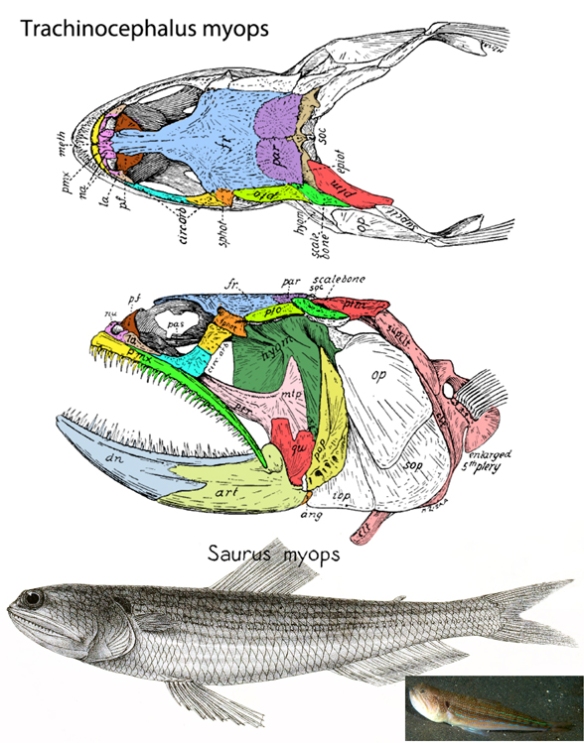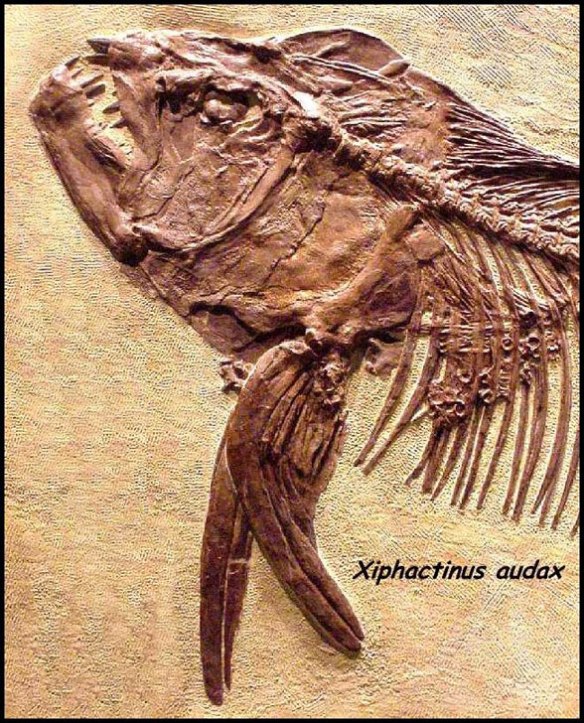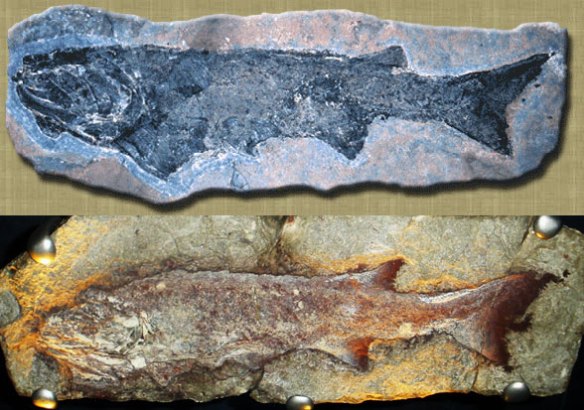Updated August 08, 2019 and October 17, 2019
with nearly 100 more taxa, many of which are close to Acanthodii.
The so-called ‘spiny sharks’ (clade: Acanthodii)
are not clearly associated with any other fish clade in the current literature.
Using 230+ generalized (not designed for fish) characters,
the large reptile tree (LRT, 1460 taxa) recovers the tiny (3.5cm, Early Devonian) Brachyacanthus (uniquely preserving a mosaic of skull bones; Fig. 1) with the giant (up to 6m, Late Cretaceous) Xiphactinus (Fig. 2). Both arise from Strunius and Gogonasus, a sister pairing we looked at earlier here. More taxa show that Acanthodii arises from Hybodus

Figure 1a. The lizardfish, Trachinocephalus with colors added. Diagram from Gregory 1936. This taxon nests with Devonian Cheirolepis, a basal ray-fin fish.
This is a novel hypothesis of relationships
that needs to be confirmed or refuted. At present it is the most parsimonious solution and the images present a gradual accumulation of derived traits, not more closely shared by any other tested taxa.

Figure 1b. Brachyacanthus is a tiny acanthodian fish with division, rather than fusion, of the facial bones, as seen in the lower image of Ischnacanthus. Some of the divisions, when grouped together, correspond to undivided and unfused bones in sister taxa in the LRT. You might call it guesswork. You might call it pattern recognition. Once again, colors clarify issues. Compare to Xiphactinus in figure 2. Contra Carroll’s 1988 caption (Fig. 6-3 above), the small scales that cover the head CAN be directly compared with the dermal skull bones of osteichthyan fishes.
Brachyacanthus scutiger (originally Climatius scutiger, Egerton 1860; Hunterian Museum and Art Gallery specimen # 298251; 3.5 cm in length) is a tiny acanthodian or ‘spiny shark’ here arising from Hybodus and giving rise to Xiphactinus (Fig. 2). The maxilla is short and posterior to the orbit. The jugal is in two parts. The postorbital is a crescent. Teeth are absent. The ‘scapulocoracoid’ is the cleithrum. Distinct from other acanthodians, the bones split up, rather than fuse together. The fin rays coalesce to form spines.
Xiphactinus audax (Leidy 1870; Late Cretaceous; up to 6m in length) was a large traditional ray-fin fish. In the LRT it is a sister to tiny and toothless, Brachyacanthus (Fig. 1), both derived from Cheirolepis and Gogonasus. The teeth are fewer but longer and stronger. The lacrimal and jugal are broken into several parts. The frontal and parietal are fused. The postparietal is a tall sagittal crest. The ‘open’ cheek is composed of vertically rotated/expanded palate bones, the palatine and pterygoid. The tall quadrate is exposed. The skull is taller than wide.

FIgure 3. Xiphactinus pectoral fins are not fragile ray-fins, but are compressed to form something similar to the spine-like fins seen in Brachyachanthus (Fig. 1). Even so, this taxon is a sister to Coryphaena, the mahi-mahi.

Figure 4. Cheirolepis fossils. Note the origin of spines anterior to fins here.
What about those spine-like fins?
Some spiny sharks (Acanthodii) have a single spine framing a soft tissue fin. Others, like Brachyacanthus, have a bundle of spines creating a pectoral fin. The same trait is found in Xiphactinus (Fig. 3), but apparently misjudged until now. Given the 200 million year interval, perhaps this is what evolution came up with, following basic acanthodian and earlier blueprints. Perhaps this represents an atavism.

Figure 5. Subset of the LRT, focusing on fish for July 2020.
In evolution, as we’ve learned several times,
if your ancestors had a trait, it is buried in your genetic code, waiting to come out.
References
Egerton P de MG 1860. Report of the British Association for Science for 1859.
Transactions of the Sections. 116.
Leidy J 1870. [Remarks on ichthyodorulites and on certain fossil Mammalia]. Proceedings of the Academy of Natural Sciences, Philadelphia 22:12–13.
Newman M and Davidson B 2010. Early Devonian fish from the Midland Valley of Scotland. National Palaentological Congress London.14–15.
